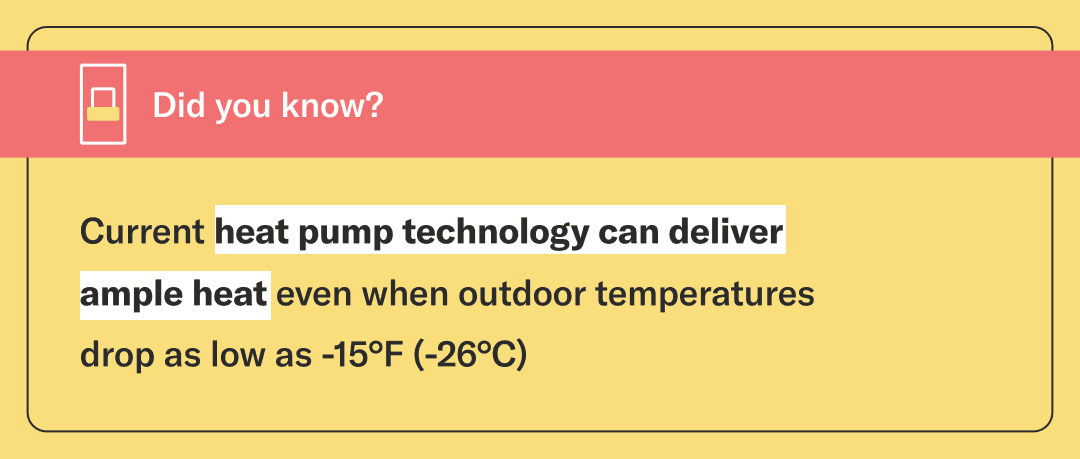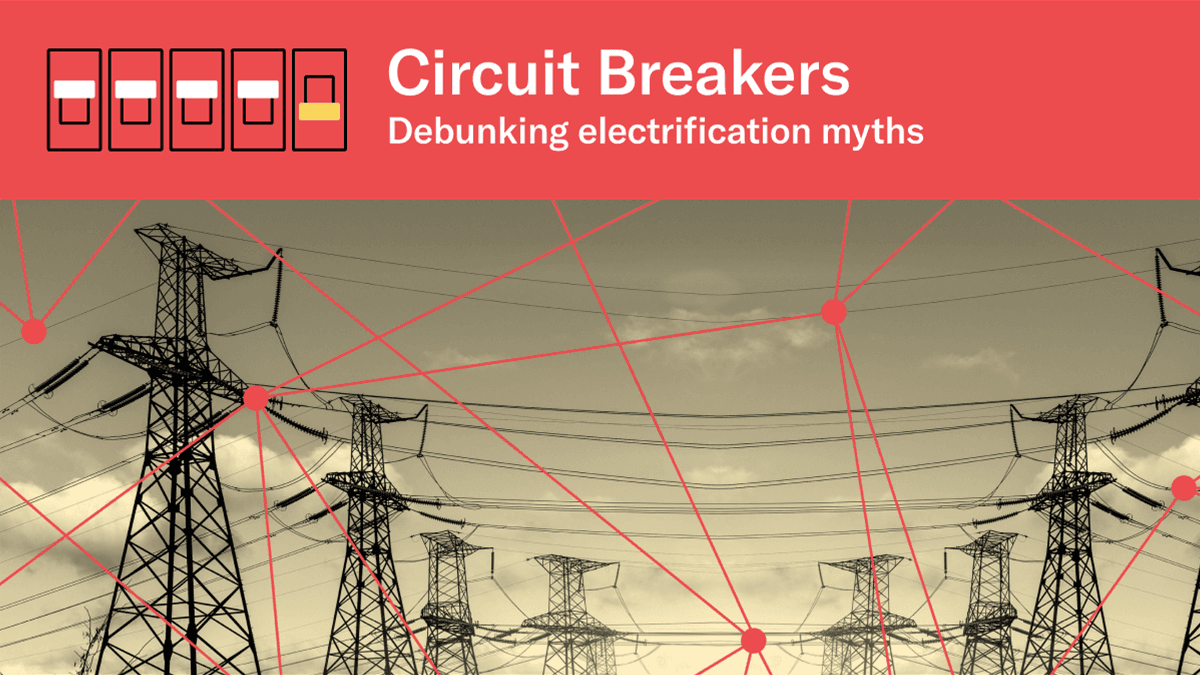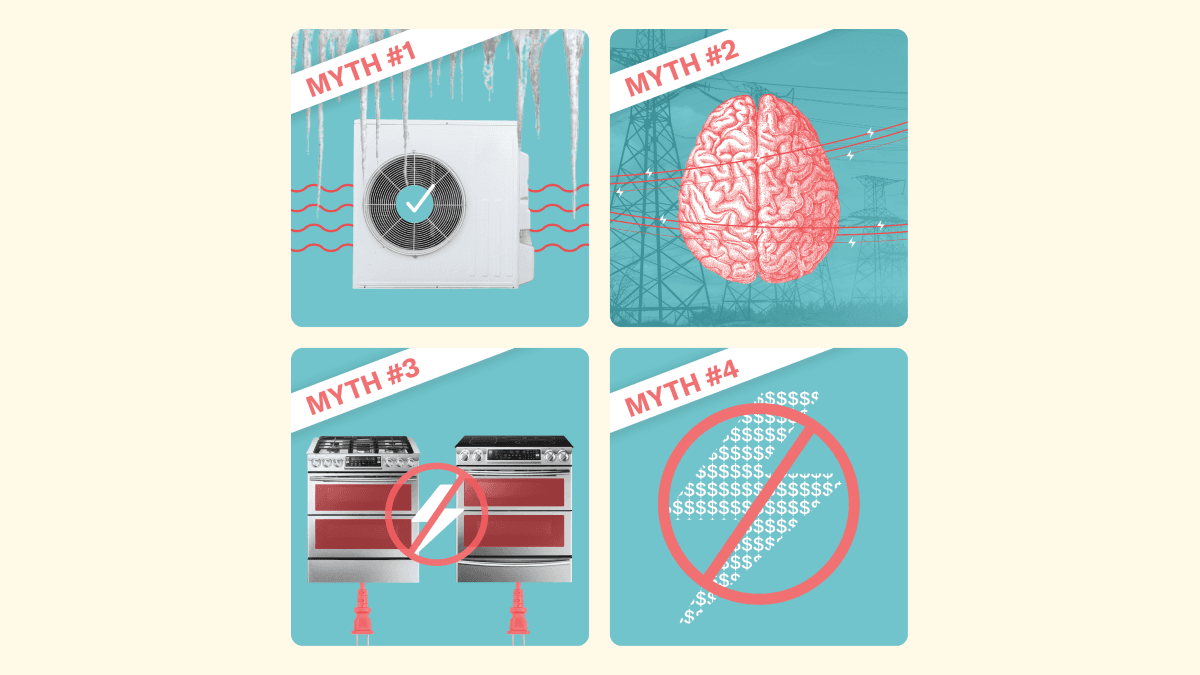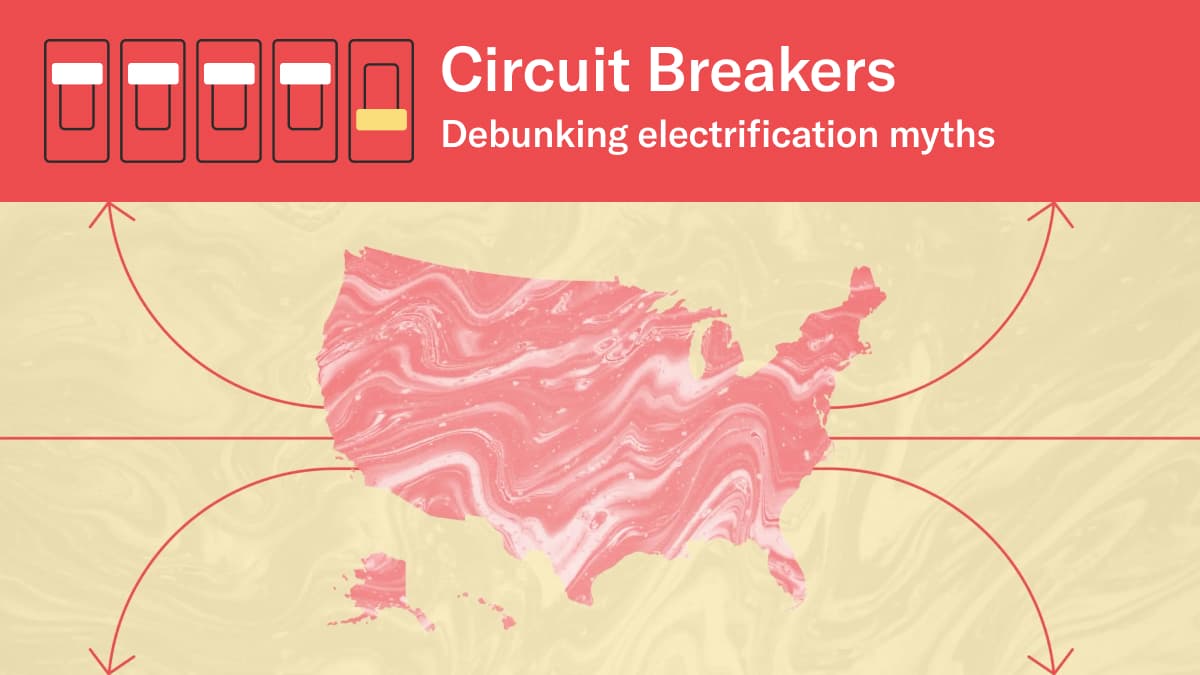There is no debate
Heat pumps are the cleaner choice. Even under conservative DOE minimum efficiency standards and 100-year global warming potentials, 98% of U.S. households would cut their carbon emissions by installing a heat pump. If all single family homes in the U.S. adopted heat pumps, the total annual emissions reduction would be at least 160 million metric tonnes by 2032.

Electrification of residential space and water heating is an enormous opportunity to cut greenhouse gas pollution [1] while also helping American households save money on their energy bills and realize the health benefits of improved air quality [2]. Electric heat pumps, which heat homes and water far more efficiently than fossil-fuel appliances or older electric resistance machines [3], are the key enabling technology. Heat pumps have improved in performance dramatically in recent years [4], particularly in cold climates, as many models can deliver ample heat even when outdoor temperatures drop as low as -15°F (-26°C) [5]. Because heat pumps also provide highly efficient air conditioning, they are crucial for resilience and public health in many regions of the country as climate change leads to more frequent and severe heat waves.
Federal incentives, like the proposed changes to the 25C tax credit and the High Efficiency Electric Home Rebate Program (HEEHRA), are critical to unlocking heat pump adoption and their pollution reductions. This will also enable the market to drive further cost reductions, as is already well underway with solar and electric vehicles.
Because the emissions associated with residential heating are complex to quantify and subject to change over time, analyses can vary in their estimates for how much cleaner electric technologies are than gas appliances. Despite this, there is agreement among researchers that, today, a heat pump will be responsible for fewer emissions than a high efficiency gas appliance in nearly every household in America, even in states where the electricity grid is still powered predominantly by coal and gas [6]. Here we discuss the key factors that make heat pumps cleaner than gas appliances, and the reasons why some studies may underestimate their climate benefits.
Emissions from gas-fired heating equipment come from two sources: (1) direct combustion of fuel on site, and (2) leaks throughout the gas distribution network and from pipe fittings inside the home. Direct combustion emissions are straightforward to calculate [7], and many estimates only include this component. Because methane, the predominant ingredient in natural gas, is such a potent greenhouse gas—30 to 80 times more powerful than carbon dioxide [8]—even small leaks have significant climate impacts. Approximately 3% of natural gas is lost to leaks on the way from well to customer [9]; when these are attributed to the gas-fired HVAC appliance, the associated emissions increase by approximately 40% using 100-year GWP values (and 115% with 20-year GWP). Importantly, while upgrading an old furnace to a high efficiency gas appliance may reduce direct combustion emissions, the emissions from leaks will remain largely unchanged [10].
Emissions from heat pumps are determined by different factors: (1) the amount of electricity required to run the heat pump, (2) the carbon intensity of local electricity, and (3) leaks of the refrigerants used to run the heat pump. Analyses based on older, less efficient heat pumps will overestimate the amount of electricity required, and hence overestimate emissions, particularly in cold climates [11]. The carbon intensity of electricity is also often overestimated, because the grid is decarbonizing rapidly [12] due to the fact that solar and wind already have lower levelized costs of electricity than fossil fuels [13]. In 2020, 17 states generated the majority of their electricity from carbon-free sources, up from 12 states just five years prior [14]. Any emissions estimate must take into account the trend towards lower carbon electricity; because heat pumps generally last 15-20 years [15], they are appreciating climate assets. Finally, heat pump refrigerants can leak due to improper fitting of their lines during installation, causing emissions. The amount of refrigerant used in a heat pump, however, is so little that the equivalent emissions are an order of magnitude smaller than methane leaks from gas-fired equipment, and the U.S. is already transitioning to refrigerants with low global warming potential [16].

When these factors are all included, heat pumps reduce emissions in the average household in every state when compared against the highest efficiency gas-fired equipment available. Even under conservative DOE minimum efficiency standards and a 100-year global warming potential of methane, 98% of U.S. households would cut their carbon emissions by installing a heat pump today, based on their combination of climate, electricity generation mix, physical housing characteristics, and heating demand profile (see [6]). Given the increased minimum efficiency standards starting January 1, 2023, and the move towards global warming potential horizons consistent with climate outcomes (see [8]), this 98% should be considered a lower bound on the portion of households seeing emissions reductions.

Under the same conservative assumptions, if all single family homes in the U.S. adopted heat pumps, the total annual emissions reduction would be at least 160 million metric tonnes — equivalent to taking 32 million cars off the road.
But even if there are a small number of households where heat pump emissions are slightly higher today, this is not a reason to delay deployment:
Heat pumps are accessible to all households: Natural gas is simply not available to a huge portion of U.S. households; less than half of U.S. households currently use natural gas for space heating [17]. If not for heat pumps, these households will be forced to heat with older, much less efficient electric resistance technology, or delivered fuels like propane or fuel oil. These options carry significantly higher energy costs and pollution than electric heat pumps.
Early adopters have large emissions reductions: The areas where heat pump emissions reductions are the greatest are largely the same areas where energy bill reductions are the greatest (see [6]). This means that early adopters of heat pump technology will predominantly be those with large emissions reduction potential. These early adopters will drive grid and market transformation, bringing both emissions and cost reduction benefits to the full population.
Electrification is the pathway to deep decarbonization: Any climate policy must not simply reduce emissions myopically in the short term, but rather set up a path to zero emissions as quickly as possible. Any additional investment in fossil fuel HVAC equipment locks in emissions for 15-30 years, and is not on the path to staying below 1.5°C (or even 2°C) of warming. Efficient electric appliances powered by a clean grid is the only true zero emissions option, one which we must move towards with all haste.
Notes:
[1] We often use the term pollution to characterize fossil fuel emissions in order to highlight the range of detrimental effects, including not only climate impacts but also adverse effects on human health and natural ecosystems.
[2] Rewiring America’s Personal Electrification Planner shows the economic benefits to American households from electrification. RMI’s Gas Stoves: Health and Air Quality Impacts and Solutions and Uncovering the Deadly Toll of Air Pollution from Buildings highlight the health impacts of burning fossil fuels in our homes and buildings, and the health benefits of electrification.
[3] Heat pumps, like refrigerators, exploit thermodynamic cycles to move heat between the inside and outside of a space, rather than burning a fuel to create heat directly. While a top-of-the-line gas furnace might reach 95-98% efficiency (some heat is always lost as the toxic combustion byproducts are exhausted out the chimney), a modern heat pump can reach 300-500% “efficiency”, because the amount of heat moved can be many times more than the electricity it takes to drive the pump. This measure of efficiency is often called the coefficient of performance, defined as the ratio of heat moved to the amount of electricity consumed. Besides heating, heat pumps can also provide cooling. In fact, a conventional air conditioner actually is a heat pump, just missing a reversing valve, the critical component allowing bidirectional operation. Because of this, the advantages of heat pumps extend beyond the heating season, as they often displace antiquated air conditioning equipment, reducing energy intensity during the cooling season.
[4] The Department of Energy’s page on Heat Pump Systems is a good primer on developments in this technology.
[5] The Northeast Energy Efficiency Partnerships (NEEP) Cold Climate Air Source Heat Pump list contains coefficient-of-performance and capacity curves for 30,700 heat pump models. Many, like Fujitsu Halcyon 8908615 and Airstage J-IVs, report impressive performance down to -15°F (-26°C). Critically, NEEP has written a new specification for manufacturers to report device performance that captures cold climate performance like this. Previously, the standard was the Air-Conditioning, Heating, and Refrigeration Institute (AHRI) Standard 210/240 which only reports performance to 17°F.
[6] For instance, a 2020 journal article in Nature: Sustainability analyzed 59 world regions and found that the emission intensity was 35% lower than fossil heating on average, and that even with no new policies to decarbonize electricity generation, heat pumps reduce emissions from 97% of heating demand. A 2020 study by Sierra Club found that heat pumps cut both climate and health pollution in every state in the U.S. A 2020 study by RMI found that heat pumps reduced emissions in all but two states in the U.S., but this analysis did not include fugitive emissions from leaked natural gas, giving fossil fuels an unfair advantage. In its analysis, the International Energy Agency reports a 55% emission reduction in the U.S. from heat pumps compared to the most efficient condensing gas boilers.
A 2021 journal article in Environmental Research Letters performed an intensive analysis, including local weather, electrical generation mix, and housing characteristics, finding that heat pumps reduce carbon emissions in 98% of U.S. houses, while in the remaining 2%, the emissions increases are miniscule. Critically, this analysis uses a conservative 100-year GWP value for methane, rather than the 20-year value, which is becoming standard. Further, this study also uses the current DOE minimum efficiency requirement for heat pumps (14.3 SEER, 8.5 HSPF), that is, the lowest performing heat pump available on the market. Starting January 1, 2023, these standards will increase, only higher performing heat pumps will be available. For these reasons, 98% is really a lower bound on the fraction of houses seeing emissions reductions. If all U.S. single family homes adopted heat pumps, the study finds a total annual emissions reduction of 160 million metric tonnes by 2032. Moreover, the study finds that public benefits (emissions and health damage reductions) are strongly correlated with private benefits (reduced energy bills), meaning that the early adopters of heat pump technology are likely to come from regions where the emissions and health benefits are strong. (Note: This study also uses a net present value framework to compare climate and health damages from heat pumps and gas fired technology. This relies on a value for the “social cost of carbon”, to convert physical units of emissions into an economic dollar amount. Unfortunately, the study uses $40/ton, rather than $51/ton, the value found by President Biden’s Interagency Working Group on Social Cost of Greenhouse Gasses. Because of this, the study overweights the health damages of heat pump deployment (mainly criteria pollutants from fossil power plants supplying electricity), therefore underestimating the number of houses with positive combined health and climate benefits from heat pumps.)
[7] For instance, the EPA publishes guidance on calculating direct emissions from stationary sources.
[8] The International Energy Agency’s Methane and Climate Change page contains a good background on the importance of controlling methane emissions, including its global warming potential (GWP) values. GWP values are an emissions “exchange rate”, used to analyze the climate effects of different gasses in a single metric, one tied to the warming effects of carbon dioxide. Because the physics and chemistry of gasses in the atmosphere is time dependent, the GWP of a greenhouse gas is determined by the time horizon over which its effects are evaluated. There is an ongoing debate on whether to continue using 100-year time horizons as the standard, or switch to 20-year values. Supporters say 20-year horizons are more relevant to the time scales required for climate action, while detractors say they overstate the need to mitigate emissions of short-lived greenhouse gasses, at the expense of reigning in longer-lived gasses like carbon dioxide. The 30-80 range given for methane reflects this: the 100-year GWP is 27.9, while the 20-year value is 81.2 (The IPCC reports updated GWP values for both time horizons in IPCC AR6, Chapter 7 Supplementary Material). A 2022 article in Environmental Research Letters recommends a sensible alternative, aligning GWP values not to arbitrary time horizons, but instead to specific climate targets. In this framework, the GWP of methane relative to 1.5°C of warming is 75, while relative to 2°C it is 42. In other words, if 1.5°C is the climate outcome we are targeting, we should consider methane emissions to be 75 times as potent as carbon dioxide when planning our mitigation strategies.
[9] Tracking methane leaks is difficult, but recent data shows the leaks are extensive. A 2021 journal article in PNAS found that the majority of U.S. urban natural gas emissions were not accounted for in greenhouse gas inventories, finding an average leak rate between 3.3 and 4.7% from well to urban customer. A 2018 journal article in Science found that methane emissions were 60% higher than previously estimated by the EPA, estimating approximately 2.3% of the U.S. gross gas production is lost to leaks. Other studies have found even higher values, for example a 2011 study estimated the leak rate at 3.6-7.9%. The Gas Index ranks cities on how leaky their distribution networks are, and contains good background information on the nature of the leaks and their implications. A 2021 article in Environmental Science and Technology found that gas stoves alone leak 0.8-1.3% of the gas they burn, with the majority occurring when the stove wasn’t even in use.
[10] Research suggests that behind-the-meter leaks tend to be small relative to the scale of the natural gas industry, but when taken together over all customers and end-uses, they can become a nontrivial category of emissions. A 2019 article in Environmental Science & Technology estimates that behind-the-meter leaks in residential homes account for approximately 2% of total methane emitted from the natural gas sector. Furnaces are the largest single contributor, accounting for approximately 0.14%. Research is ongoing about the extent to which upgrading a furnace may reduce this category of leaks, but the fact remains these leaks are tiny relative to the scale of those throughout the system supplying gas to the furnace: in production, processing, transmission, storage, distribution, and metering.
[11] In older heat pumps, performance was significantly reduced at even moderate temperatures. In cold climates, an electric resistance backup heater is usually used, which consumes considerable electricity when supplementing these older models.
[12] Based on current trends, the National Renewable Energy Lab (NREL) predicts a 38% reduction in the carbon intensity of electricity by 2040, and a 50% reduction by 2050. President Biden has been much more aggressive, signing an executive order to produce 100% carbon free electricity by 2030. Any HVAC equipment placed into service today is likely to last until 2036-2051, and so the associated emissions of electric equipment will drop significantly as the grid is decarbonized.
[13] The levelized cost of electricity (LCOE) is the key driver of investment in generation technologies, as it quantifies the price of a unit of electricity after all the lifetime costs of a generation facility have been incorporated. The financial management firm Lazard regularly publishes its data on LCOE.
[14] The U.S. Energy Information Administration reports detailed state-by-state information on electricity generation by fuel source. The U.S. EPA’s Emissions & Generation Resource Integrated Database (eGRID) contains extensive data on fuel mix, emission rates, etc. The National Renewable Energy Lab’s Cambium dataset contains marginal emission rates, the rate of emissions induced or avoided by a change in electrical demand.
[15] Appliance lifetime is influenced by many factors, including local climate, installation practices, and usage frequency, but NREL maintains the National Residential Efficiency Measures Database, which contains rough estimates.
[16] Refrigerants in residential heat pumps today can leak due to improper fitting of refrigerant lines during installation. Averaged over all devices, the annual leakage rate is approximately 3.5% (see Impacts of Leakage from Refrigerants in Heat Pumps and IPCC SR05: Residential and Commercial Air Conditioning and Heating). The average charge of refrigerant in a residential heat pump is between 1-5 kilograms (c.f. Fujitsu Halycon 12LZAS1 and 45RLXFZ). R-410a, the most commonly used refrigerant in heat pumps (see BSRIA), is a greenhouse gas with 100-year global warming potential of 2,255 (see IPCC AR6, Chapter 7 Supplementary Material). R-410a will be eliminated from all new products in January 2023 (see American Innovation and Manufacturing (AIM) Act of 2020), being replaced by R-454b and R-32, refrigerants with 100-year global warming potentials of 531 and 771 respectively. Taken all together, this means a heat pump with R-410a contributes the equivalent emissions of about 200 kg of CO2 per year, while a heat pump with R-454b contributes the equivalent of just 48 kg. Compared to the roughly 1000 kg of equivalent carbon emissions from the fugitive emissions of the natural gas supply chain required to power a residential HVAC system, these numbers are 5-20 times lower.
[17] See the U.S. Energy Information Administration’s Residential Energy Consumption Survey, Table 6.1.



